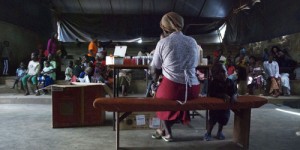Innovation for Health: How Text Messages and Micro-Insurance Help the Urban Poor Stay Healthy | Source: Huffington Post, July 17, 2013 |
Slum residents across the Global South lack access to affordable health care services. Despite a pervasive lack of funding, often mediocre infrastructure, and too few trained personnel, slum dwellers have come up with innovative solutions. Using forums, text messages, micro-insurance, and community engagement, they help residents in Mumbai, Nairobi, Jakarta, Rio de Janeiro, and Mexico City lead healthier lives.
In Mumbai, Innovation Alchemy recently hosted an open forum on urban issues that featured innovators, investors, creative minds, engaged citizens, and entrepreneurs. The discussion featured two main social enterprises: Swasth India, which provides low-cost and discounted health care services to slum dwellers, and WaterWalla, which sources and introduces clean water technologies into Mumbai’s informal settlements. The session put an emphasis on the need and opportunity for breakthrough innovation designed for, and implemented with, the urban poor — a rapidly growing challenge in cities such as Mumbai, where 54 percent of the population lives in slums.
The M-chanjo project was launched to harness the power of mobile phones to ensure that young children living in Nairobi’s marginalized communities receive all of their important vaccinations. The program takes advantage of rising mobile phone ownership rates and low SMS sending costs: clinics draw up a large database of parents, to which they send automated messages on a regular basis. The text messages keep medical patients up to date on their upcoming inoculations, provide suggestions to help parents prevent and cure their children’s everyday medical problems, and send info about any outreach programs that are due to take place in the area. 
Only 12 percent of Indonesians have health insurance, so illness can be disastrous for Jakarta’s poor. In response, a number of innovative micro-insurance schemes have been launched: the Dengue Fever Insurance Card offers protection from a disease that forces patients to spend an average of five days in the hospital, at a cost of IDR 3.5 million (about USD $350). There are two choices of cards, costing either IRD 10 000 or IRD 50 000, which cover hospital fees up to IRD 1 000 000 and IRD 2 000 000, respectively. Customers can even activate the claim by sending a text message. Other micro-insurance schemes like Tamadera and Family Umbrella combine life insurance and savings plans, and target women and families.
In March 2012, Brazil’s Health Ministry’s Unified Health System Performance Index ranked Rio de Janeiro last among Brazil’s capital cities and municipalities in terms of adequate health infrastructure. Viva Rio, a part-research, part-service-delivery institution, is one of the organizations working to improve basic health service coverage. The organization operates as a service provider with the local government, planning interventions and designing joint training courses to guarantee the coordination of efforts. Viva Rio also invests in its personnel, emphasizing the added value of well-trained staff, and focuses on prevention practices rather than just reacting to emergencies.
In Mexico City, the Urban Health Project combines the research and teaching of academia with the health needs of the population in a cooperative, participatory model. By approaching poor communities through community organizations, the program creates an alliance between civil society organizations and vulnerable residents to upgrade health infrastructure, like nursing homes and clinics. Health professionals offer Mexico City residents first-class care through services (clinical care, general medicine, and immunizations), health promotion (based on participatory research and education strategies), and health research.
All of these programs are crucial steps in innovating to improve health in the Global South. Visit URB.im to join the conversation and to learn more about these and other creative health initiatives.





